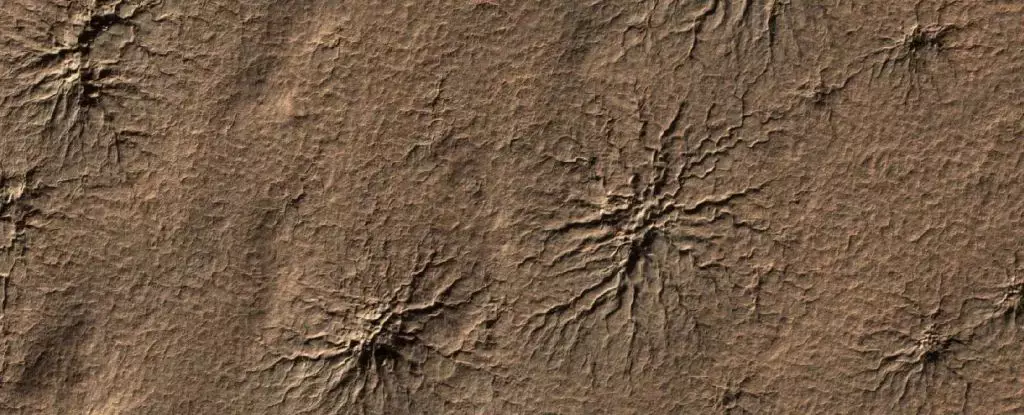Among the captivating phenomena that adorn the surface of Mars, the peculiar spider-like shapes known as araneiforms stand out, igniting both intrigue and mystery for scientists and enthusiasts alike. These structures, depicted in satellite imagery, stretch across the ocher dunes and rugged terrains of the southern polar region, resembling the intricate legged forms of terrestrial spiders, yet are devoid of any biological origins. Instead, they manifest as patterns crafted from the Martian dust and the forces of the planet’s unique seasonal cycles. The study of these features not only reveals details about the Martian environment but also enhances our understanding of planetary processes beyond Earth.
The Nature of Araneiforms
Araneiforms are fascinating geologic features that materialize each spring as temperatures on Mars begin to rise. Unlike Earth, where liquid water plays a crucial role in shaping landscapes, Mars experiences extreme temperature fluctuations that significantly influence its environmental processes. The formation of araneiforms may be indicative of sublimation cycles, where frozen carbon dioxide transitions directly from a solid state to gas, skipping the liquid stage altogether. This phenomenon is not just an intriguing coincidence; it represents fundamental differences in planetary geology that distinguish Mars from Earth.
Understanding the creation of these structures involves delving into the Kieffer model, named after geophysicist Hugh Kieffer, who theorized about the processes occurring beneath the Martian surface. During the frigid Martian winter, carbon dioxide freezes onto the surface, and as spring approaches, the atmosphere begins to warm. The underlying dark material, which absorbs heat more readily than the overlying ice, can lead to the buildup of pressure as sublimated gas becomes trapped beneath the ice layers. When the pressure exceeds the strength of the ice, it creates fractures, allowing gas to escape explosively, carrying dust particles away with it. The scars that remain resemble the sprawling forms of spiders across the red landscape.
To validate hypotheses about araneiform formation, scientists, including Lauren McKeown, have taken inventive steps in the laboratory to simulate Martian conditions. They utilized a specialized chamber known as DUSTIE (Dirty Under-vacuum Simulation Testbed for Icy Environments), meticulously designed to replicate the atmospheric and temperature dynamics of Mars. Utilizing a simulant of Martian regolith, researchers subjected the material to frigid temperatures and controlled atmospheric conditions that mimic a Martian winter.
By systematically cooling the regolith and introducing carbon dioxide, the team aimed to observe how these elements interact, ultimately seeking to recreate the explosive phenomena that form araneiforms. After iterative experimentation, they witnessed the anticipated chaotic eruptions that birthed miniature versions of the spider-like structures they had been studying. Interestingly, they discovered that the carbon dioxide formed within the regolith rather than above it, leading to an entirely new insight into the dynamics of shape formation and the geological processes at play.
These findings hold broader implications, not just for understanding araneiforms but also for elucidating other seasonal features across the Martian surface. Each experiment is a thread in the intricate tapestry of Mars’ geological history, revealing how external and internal forces shape the planet’s unique landscape. Furthermore, this research invites contemplation about the interactions of various materials and gases in extraterrestrial environments.
As researchers continue to refine their methodologies and investigate the processes that govern these enigmatic shapes, it becomes evident that the desert landscapes of Mars offer valuable clues about not only the past and present of the planet but also the potential for other celestial bodies that exist beyond our immediate observation.
The quest to understand the araneiforms of Mars encapsulates the spirit of scientific discovery, intertwining creativity and inquiry across the realms of planetary science. As ambitions for Martian exploration deepen, our understanding of these unique and striking features will surely evolve. While the idea of encountering ‘alien spiders’ remains firmly in the realm of imaginative humor, the lessons drawn from araneiform formation could lead to groundbreaking discoveries about not just Mars, but the nature of geological processes on other worlds as well. Such exploration stands as a testament to humanity’s enduring curiosity and relentless pursuit of knowledge in the cosmos.

